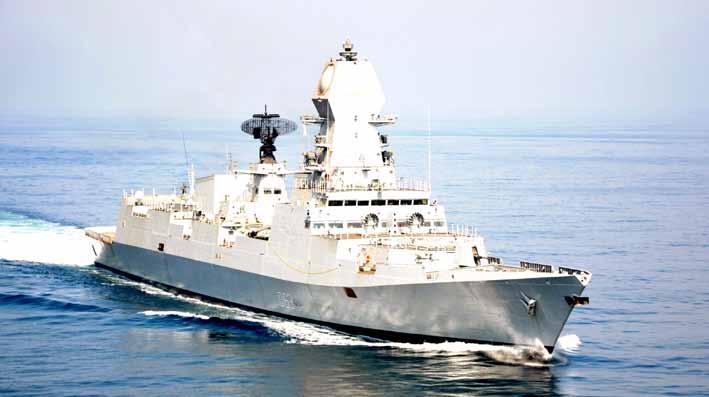
9 minute read
Building an invincible armada
In its pursuit towards creating a blue-water navy, India is depending to a large extent on domestic shipbuilding firms. The recent indigenisation initiatives launched by the Government of India are expected to give a boost to the production of warships and other vessels required by the Indian Navy, in both public and private sectors
Surrounded by oceans on three sides, India has found it essential to maintain a strong navy as well as a robust defence shipbuilding industry in order to protect the nation’s sovereignty. Moreover, around 95% of the country’s trade by volume and over 70% by value takes place by sea and the Indian Navy is the chief player ensuring security in the Indian Ocean Region.
Advertisement
Since the 1960s, the India’s Ministry of Defence (MoD) has acquired several shipyards and starting with the construction of Leander-class frigates at the Mazagaon Dock Ltd (MDL), Mumbai the Indian Navy has been developing a self-sufficient domestic shipbuilding industry. Moreover, the Indian Navy’s in-house designing capability has also improved. According to data, the Directorate of Naval Design has created blueprints for 19 ship classes and over 90 warships have been built. Significantly, more than 40 out of the over 50 ships and submarines on order are being constructed in Indian shipyards at present.
India now has eight public sector shipyards and 13 major private shipyards. Of the eight governmentowned shipyards, two are under the Ministry of Shipping, four are under the MoD and the remaining two are state public sector undertakings.
The major shipbuilding centres in India catering to the Indian Navy are the following.
MDL, Mumbai
Mazagon Dock Shipbuilders Limited (MDL), Mumbai is India’s top defence PSU shipyard under the MoD and has delivered projects such as the Nilgiri, Godavari, Delhi and Shivalik class frigates, Khukri class corvettes and Project 15A. MDL can undertake construction of vessels up to 40,000 DWT and its infrastructure consists of three dry docks, four slipways and three wet basins. In July 2016, the shipyard completed the augmentation of infrastructure through the Mazdock Modernisation Project. Major ships under construction
include the P17A (Frigate) class, four ships of P15B (Destroyer) class, and six Scorpene class submarines.
GRSE, Kolkata
Garden Reach Shipbuilders and Engineers (GRSE), near Kolkata built India’s first indigenous warship, the INS Ajay, in 1961. Over the years, it has produced vessels such as the P-16A class which was delivered to the Navy between 2000 and 2005 and three anti-submarine warfare (ASW) corvettes (P28 class). GRSE was modernised in 2013. The yard completed delivery of its 100th warship, a Landing Craft Utility (LCU Mark-IV) in June 2019. GRSE has orders in hand for 22 more warships worth over US Dollars 3.74 billion.
GSL, Goa
Goa Shipyard Limited (GSL), situated in Vasco da Gama, Goa, is the smallest shipyard under the MoD and builds medium-sized vessels for the Navy and Coast Guard. The shipyard was a small facility established in 1957 by the Portuguese, and following Goa’s independence was leased to MDL, which controlled the shipyard till 1967. GSL has the capability to build ships up to 105 metres long, 3,000 DWT and 4.5 metres draught. Its product range includes fast patrol vessels, survey vessels, sail training ships, missile craft and offshore patrol vessels. Following a US Dollars 1-billion deal in October 2016 with Russia, the Indian government signed a contract for the construction of two Project 1135.6 (Talwar class) frigates at GSL with scheduled delivery in June 2026 and December 2026. In May 2019, the shipyard launched the 10th ship of the 105 metre length improved Sankalp-class offshore patrol vessel (OPV) for the Indian Coast Guard.

HSL, Visakhapatnam
Located in Visakhapatnam, Hindustan Shipyard Ltd (HSL), the largest government shipyard, was transferred to the MoD from the Ministry of Shipping in February 2010. Having modern facilities, it has built offshore patrol vessels and inshore patrol vessels for the Indian Navy and Coast Guard, besides undertaking refit of naval submarines. With a draft of 7.5-10 metres, it can build ships up to 80,000 DWT. It is co-located with the Naval Shipyard and the Special Boat Centre where India’s nuclear submarines are built. The shipyard was modernised in 2018 to enable the construction of advanced vessels such as landing platform docks, and conventional and strategic submarines. In March 2020, the shipyard signed a US Dollars 2.3-billion deal to manufacture fleet support vessels in collaboration with a Turkish shipyard.
CSL, Kochi
Cochin Shipyard Ltd (CSL) in Kochi is India’s only non-MoD-owned shipyard involved in naval shipbuilding and functions under the Ministry of Shipping. The largest shipbuilding and maintenance facility in India, CSL has facilities to build vessels up to 100,000 DWT and repair vessels up to 125,000 DWT. The yard is now constructing India’s first ever indigenous aircraft carrier. In April 2019, CSL was awarded a Rs 6,311 crore contract to construct eight anti-submarine warfare shallow water crafts for the Indian Navy.
CSL was incorporated in 1972 as a Government of India company, with the first phase of facilities coming online in 1982. The company has Miniratna status. The first ship to roll out of the Cochin Shipyard was the MV Rani Padmini in 1981. CSL has also delivered two of India's largest double-hull Aframax tankers each of 95,000 DWT.
CSL has secured shipbuilding orders from internationally renowned companies from Europe and the Middle East. The shipyard is building six 30,000
Meet us at Hall A Stall 3.6 Advertise with AEROMAG Show Dailies & Special Issue


February 03 - 07, `21 yelahanka air Force Station, bangalore
Contact : preethim@aeromag.in editor@aeromag.in +91 9448447509 |+91 9480551925 91-80-43747492
DWT bulk carriers for Clipper Group of the Bahamas and the first three vessels have been launched. Eight platform supply vessels for the Norwegian Seatankers Management Company are also under construction.
INS Vikrant
Cochin Shipyard is currently building India's first indigenous aircraft carrier INS Vikrant. The carrier will be the largest warship built by CSL, the construction of which is expected to be completed by February 2021.
Work on the design of INS Vikrant, also known as Indigenous Aircraft Carrier 1 (IAC-1), began in 1999, and the keel was laid in February 2009. The carrier was floated out of its dry dock in December 2011 and was launched in August 2013. The ship is expected to enter into service by late 2021.
INS Vikrant is 262 metres long and 62 metres wide, and displaces about 40,000 metric tons. It features a STOBAR configuration with a ski-jump. The deck is designed to enable aircraft such as the MiG-29K to operate from the carrier. It is expected to carry an air group of up to 30 aircraft, which will include 24–26 fixed-wing combat aircraft, primarily the Mikoyan MiG29K, besides carrying 10 Kamov Ka-31 or Westland Sea King helicopters.
The ship's combat management system (CMS) was developed by Tata Power Strategic Engineering Division in collaboration with Weapon and Electronics System Engineering Establishment and MARS, Russia. It is the first CMS developed by a private company for the Indian Navy. In February 2020, all the major structural and outfitting work was declared complete by the government.
Shipyards in private sector
Larsen & Toubro (L&T) and Reliance Naval & Engineering Limited (RNEL) are the biggest Indian private sector companies engaged in defence shipbuilding. L&T participated in India’s secretive ATV nuclearpropelled submarine project, and its Hazira shipyard also built the Coast Guard’s OPV Vikram. However, RNEL, which was formerly known as Pipavav Defence and Offshore Limited, has faced problems in delivering a Naval OPV project.
The private sector has made big investments and built extensive facilities related to defence shipbuilding. L&T set up a mega-shipyard in Kattupalli in 2012 and has been operating it successfully ever since. In fact, L&T’s Rs 4,000-crore shipyard at Kattupalli delivered the fifth Vikram-class OPV to the Coast Guard in March 2020. Several experts have pointed out that the future of India’s naval shipbuilding lies in involving the private sector companies and utilizing their massive infrastructure capacity.
Pipavav also invested in a huge shipyard in the Gujarat coast near Bhavnagar, with the largest dry dock in India and the first modular construction facility in the country. But, RNEL is now undergoing process under the Insolvency and Bankruptcy Code and is facing claims from several financial creditors. Meanwhile, there are reports that United Shipbuilding Corporation (USC) of Russia has evinced interest in buying the shipyard. The Russian Embassy in India, too, confirmed this development and in a statement said USC is looking forward to acquiring RNEL.
According to experts, USC is interested in RNEL because the Russian firm is hoping to win the Indian Navy’s Project 75I, under which six conventional submarines are to be built. In case USC acquires RNEL, the company can build new submarines in India under the Make in India initiative.
The embassy said USC is

currently auditing RNEL and assessing potential investment opportunities. “UCS has passed the accreditation procedure, which provided access to electronic accounts with financial and economic documents related to the Indian company,” said the embassy.
“USC is expected to finalise its stance on further participation in the bidding procedure after completing the remote study of the documents provided by the debtor’s trustee and the field review of the RNEL’s assets by USC’s specialists,” it added.

Navy modernisation
The Indian Navy has chalked out a Maritime Capability Perspective Plan – 20122027, which envisions a force of 200 warships and 500 aircraft to guard its Indian Ocean territories. In the 2019-20 defence budget, the Indian Navy was allocated Rs 41,259 crore. The MoD has also made an amendment to its Defence Procurement Procedure-2016 (DPP) to include guidelines to support the nomination of shipyards to undertake naval construction and repair work. In its 15-year indigenisation plan (20152030), the Indian Navy has supported collaborative agreements with Indian and foreign vendors for defence equipment production in country.
In May 2020, after Prime Minister Narendra Modi called for an ‘Atmanirbhar Bharat’ or self-reliant India in the wake of the COVID-19 outbreak, Finance Minister Nirmala Sitaraman announced measures for the indigenisation of defence equipment. In August 2020, the MoD came up with a list of 101 systems that would be banned from imports in phases. This way, contracts worth Rs 4 lakh crore would be given out to domestic industries within the next seven years. Of this amount, almost Rs 1.4 lakh crore would be the share of the Navy.
Defence, AerospAce, HomelAnDsecurity news
Middle east suppleMent
www.arabiandefence.com
Publishing Special issues for IDEX & NAVDEX 2021
For publishing feature articles, interviews, & advertisements, Contact : editor@arabiandefence.com | editor@aeromagasia.com
Aeromag Asia,Aerosun Media Pvt Ltd, Aeronautical Society of India Building, Suranjandas Road, Off Old Madras Road, Bangalore 560075. Karnataka. www.aeromag.in










